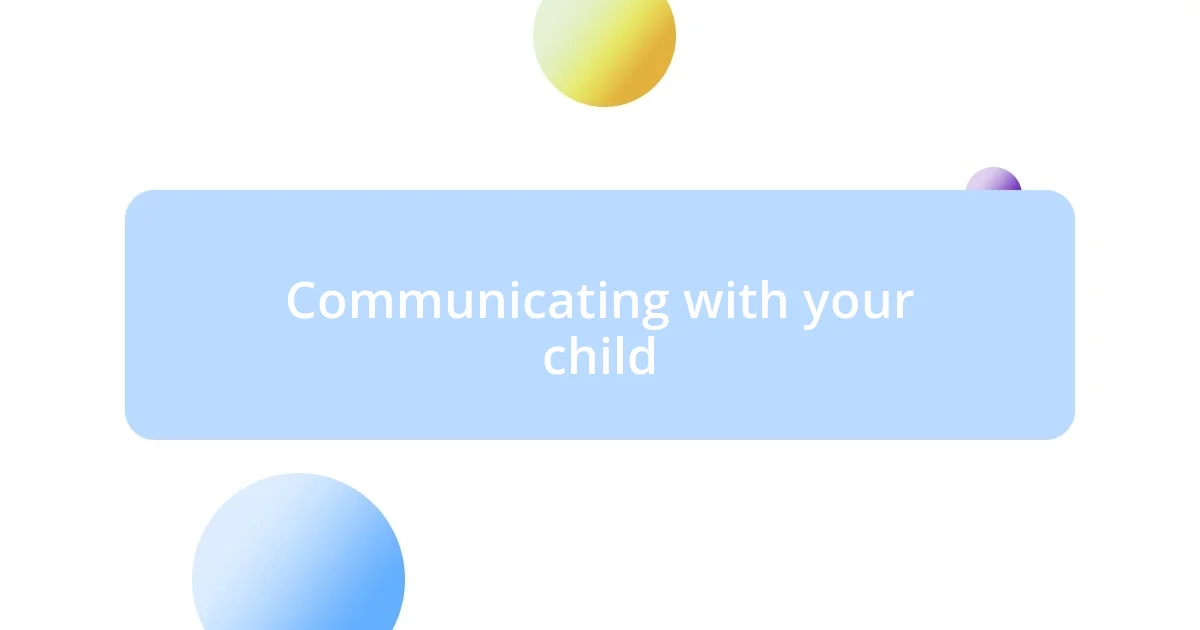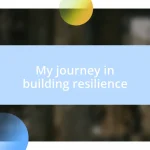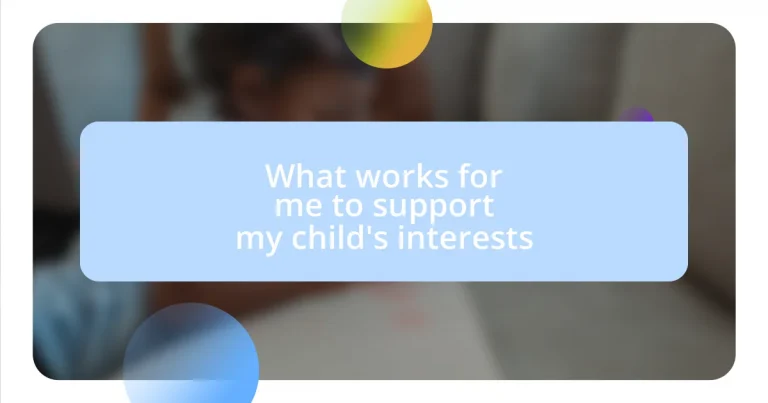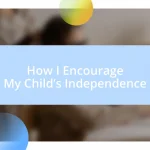Key takeaways:
- Observing your child’s natural interests and providing exposure can significantly enhance their self-esteem and identity.
- Creating a supportive environment that balances structure with freedom fosters creativity and confidence in children.
- Regular communication and adaptability in support are crucial for nurturing a child’s evolving passions and ensuring their engagement.

Identifying your child’s interests
When I first started to notice my child’s affinity for drawing, I was surprised. One day, I found a stack of doodles tucked under the bed, each one bursting with color and imagination. It made me wonder—how many parents miss these little hints? Observing such moments can reveal more than we realize about what truly lights up our kids.
As I paid closer attention, I noticed how my child would light up at art classes but seemed to lose interest when other subjects like math were mentioned. Reflecting on these observations helped me understand the importance of exposure. Have you ever encouraged your child to try a new hobby, only to see their eyes sparkle with excitement? These discoveries can shape their identity and self-esteem significantly.
Listening to what my child talks about during playtime also became a key indicator. I recall a weekend when they excitedly described a book about dinosaurs. Suddenly, I was faced with a question: how do I enhance this newfound passion? By offering themed activities and encouraging the exploration of related topics, I found it not just nurtured their interests but also deepened my connection with them. Remember, sometimes the simplest conversations can lead to the most profound insights.

Encouraging exploration and creativity
Encouraging exploration and creativity in my child has become one of the most fulfilling aspects of parenting. I remember one rainy afternoon when we decided to raid the craft supplies. Armed with scissors, glue, and an assortment of papers, we ventured into a world of creativity, making everything from collages to homemade greeting cards. Witnessing the joy on my child’s face as they transformed ordinary materials into something uniquely theirs was a pure delight. It became clear that allowing them the freedom to experiment nurtured not just their creativity but also their confidence.
To support this exploration, here are some strategies I’ve discovered that can truly inspire creativity:
- Create a DIY art corner: Setting up a dedicated space with supplies encourages spontaneous creativity.
- Explore nature: Take them for nature walks and collect leaves or stones, sparking imaginative play opportunities.
- Encourage storytelling: Ask them to create stories based on their drawings, turning art into a narrative experience.
- Limit structured activities: Allowing downtime or unstructured playtime gives children the freedom to invent and create without constraints.
- Join in the fun: Participate in their creative projects—sometimes, sharing the experience inspires them even more.
Incorporating these strategies has helped me understand that creativity flourishes best when it’s woven into daily life—a lesson that not only enriches my child’s world but enhances our relationship.

Providing resources and materials
Providing resources and materials is a crucial aspect of supporting my child’s interests. When I first discovered my child’s fascination with painting, I made a trip to the local art supply store. I remember feeling a wave of excitement as I picked up vibrant paints, various brush sizes, and canvases. The sheer joy in their eyes as they unwrapped each new item reminded me how important it is to provide the right tools for their creative expression. Without these materials, their artistic journey might have felt limited.
Sometimes, it’s about more than just tangible supplies. I’ve found that incorporating books and online tutorials related to their passions can open up new worlds for them. For instance, after our painting session, we began exploring books about famous artists. It amazed me how much their understanding of art deepened simply by seeing how others approached creativity. Engaging with resources that are both fun and educational creates opportunities for them to further develop their interests.
In my experience, organizing materials in a way that encourages accessibility can really make a difference. I once spent a weekend creating labeled bins for different art supplies. This simple act empowered my child to choose what they wanted to work on whenever inspiration struck. I believe that when children feel they have control over their creative resources, their confidence soars, leading to even more exploration and joy in their passions.
| Type of Resource | Benefit |
|---|---|
| Art Supplies | Encourages creativity and self-expression |
| Books on Artists | Inspires learning and understanding |
| Online Tutorials | Provides guidance and new techniques |
| Organized Storage | Promotes independence and confidence |

Creating a supportive environment
Creating a supportive environment is essential for nurturing my child’s interests. One thing I’ve found is that the space we create can significantly impact their creativity. For example, I transformed a small corner of our living room into a mini art studio. I noticed that when my child had a cheerful and organized space filled with colorful supplies, they were much more inclined to dive into their projects. Isn’t it fascinating how our surroundings can inspire creativity?
I also believe that emotional support plays a huge role in fostering confidence. I still recall a moment when my child hesitated to share their latest drawing with me. I encouraged them by expressing genuine excitement and curiosity about their work. Their apprehension melted away, replaced by a proud smile. This experience taught me that being emotionally present and enthusiastic encourages my child to take bold creative risks. How often do we forget the power of our words and expressions in shaping a child’s self-esteem?
In addition to physical and emotional support, I find that maintaining a balance between structure and freedom is crucial. There are days when I plan specific activities, but I’ve learned that leaving room for spontaneous moments can lead to magic. One evening, we randomly decided to create a storybook together using old magazine clippings. The laughter and collaboration in that unplanned project highlighted how flexibility in our creative space can lead to unique experiences. How do you strike that balance in your own home? I realize now that it’s the unexpected moments that often become the most cherished memories.

Engaging with community activities
Engaging with community activities has truly enriched my child’s interests and brought about a sense of belonging. I recall the first community art fair we attended; it was a vibrant explosion of color and creativity. Watching my child interact with local artists and participate in workshops was exhilarating. There’s something magical about stepping into a space where curiosity and creativity collide, isn’t there? It opened their eyes to the idea that art exists beyond our home, making their passion feel limitless.
Participating in extracurricular programs through our community has also been incredibly beneficial. Just last month, my child joined a local theater group, and I can’t tell you how much their self-confidence has blossomed since then. I watched them rehearsing lines at home, their enthusiasm contagious. The joy of performing in front of an audience made them shine; it’s as if I saw a new layer of their personality emerge. Have you ever noticed how discovering new skills can transform a child’s perception of their abilities?
Furthermore, I’ve discovered that volunteering for community events can provide invaluable experiences. At a recent local festival, we helped set up art booths together. Not only did this strengthen their sense of community, but it also taught them the importance of collaboration and giving back. Seeing the smiles on the faces of attendees as they admired the artwork we had a hand in showcasing was heartwarming. What better way to encourage my child’s passion than by connecting it to our community? Engaging with activities outside our home not only nurtures their interests but also builds lasting memories.

Communicating with your child
Communicating with your child is a vital part of supporting their interests. I remember a day sitting at the kitchen table while my child lit up with enthusiasm over a science project. Instead of simply listening, I asked follow-up questions that tapped into their excitement, like, “What do you find most fascinating about this experiment?” That little shift from passive listening to active engagement brought out a depth of creativity and thoughtfulness that surprised even me. How often do we take the time to dig deeper into our child’s passions?
I’ve learned that tone and body language speak volumes during our conversations. One afternoon, my child was frustrated after a difficult day, and I found myself instinctively kneeling to their level, making eye contact, and speaking softly. That simple act of being present, both physically and emotionally, opened up a floodgate of feelings and ideas. The way they shared their experiences reminded me of the trust we can build through authentic communication. Have you ever considered how a comforting presence can facilitate a more open dialogue?
In addition, I’ve noticed that sharing my own experiences fosters connection and understanding. When my child expressed interest in my childhood love for astronomy, I shared stories of how I would gaze at the stars and dream. That moment sparked an inspiring discussion about their own aspirations and how they might connect with the cosmos. It reinforced the idea that our stories bridge generational gaps, prompting reflection and sparking curiosity. What stories from your own life could inspire your child to delve deeper into their interests?

Evaluating and adapting support
Evaluating and adapting support requires a keen eye on your child’s evolving interests. I recall a moment when my child discovered a love for cooking. Initially, I focused on simple recipes, but as their interest grew, I saw a spark in them when they experimented with their unique flavors. It was fascinating to watch their culinary confidence blossom, reminding me that flexibility in support can lead to uncharted territories of creativity.
It’s crucial to observe the signs of engagement and joy in your child’s activities. One day, during a painting session, I noticed my child was not only disinterested but also frustrated. Instead of pushing through, I paused and asked what they would like to explore instead. To my delight, they uncovered a new passion for photography that day! This taught me that adapting support isn’t just about following a plan; it’s often about listening and being in tune with their emotions and desires.
I also find that regular check-ins about their experiences can illuminate pathways for future growth. After my child joined a music class, we set aside Sunday evenings to chat about what they enjoyed. Some weeks they were excited about learning rhythm, while others focused on songwriting. This dialogue not only informed my support but also helped them feel empowered in shaping their own learning journey. Have you considered how different experiences can refine your understanding of your child’s interests?














